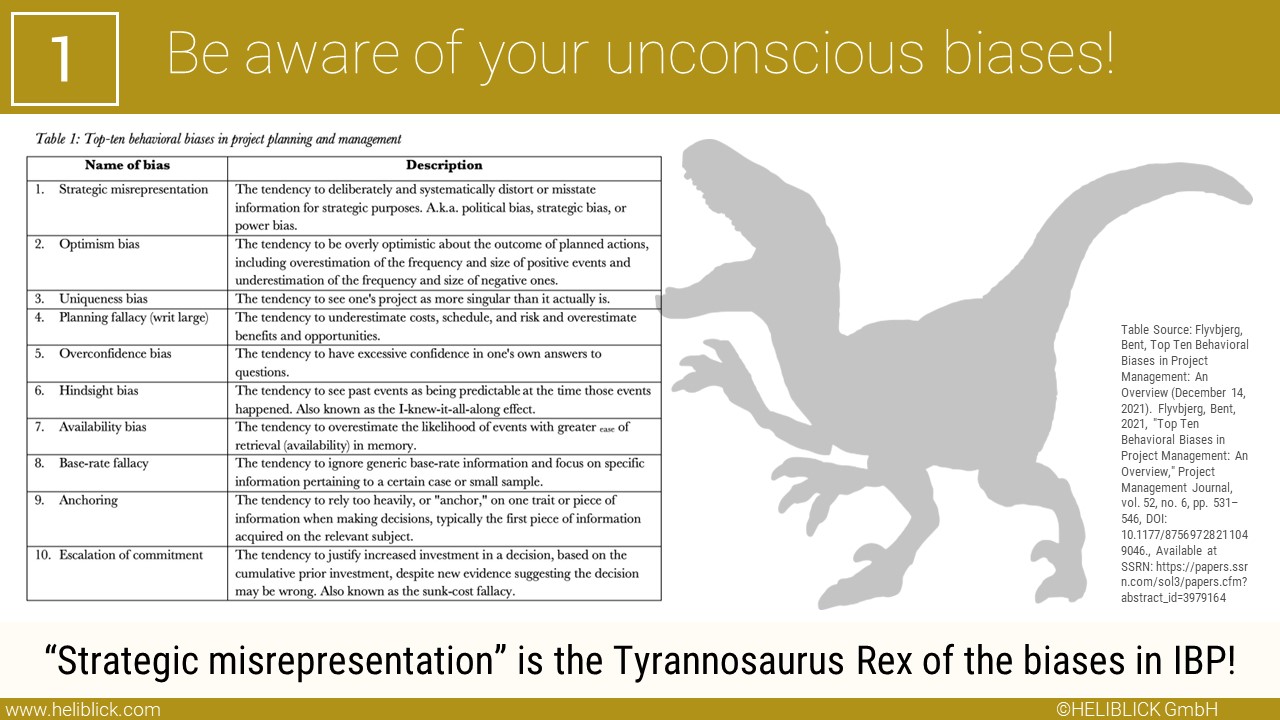S&OP / IBP without bias seems impossible. Much can be gained by creating awareness of different manifestations of bias during the implementation and execution of S&OP.
Here are a few examples of bias in an IBP / S&OP context:
⇨ “𝐎𝐯𝐞𝐫-𝐬𝐞𝐥𝐥𝐢𝐧𝐠” is a smart paraphrase for “Under-forecasting Bias” – who can be blamed for selling “too much”? There may be many reasons for “under-forecasting” behaviour such as 𝘣𝘢𝘴𝘦-𝘳𝘢𝘵𝘦 𝘧𝘢𝘭𝘭𝘢𝘤𝘺 or 𝘢𝘯𝘤𝘩𝘰𝘳𝘪𝘯𝘨.
⇨ “𝐎𝐯𝐞𝐫-𝐟𝐨𝐫𝐞𝐜𝐚𝐬𝐭𝐢𝐧𝐠 𝐨𝐟 𝐍𝐏𝐈 (New Product Introduction) 𝐯𝐨𝐥𝐮𝐦𝐞𝐬” and “𝐭𝐨𝐨 𝐨𝐩𝐭𝐢𝐦𝐢𝐬𝐭𝐢𝐜 𝐍𝐏𝐈 𝐭𝐢𝐦𝐞𝐥𝐢𝐧𝐞𝐬” is also a typical phenomenon in S&OP and may be caused by 𝘶𝘯𝘪𝘲𝘶𝘦𝘯𝘦𝘴𝘴 𝘣𝘪𝘢𝘴, 𝘰𝘷𝘦𝘳𝘤𝘰𝘯𝘧𝘪𝘥𝘦𝘯𝘤𝘦 𝘣𝘪𝘢𝘴, 𝘢𝘷𝘢𝘪𝘭𝘢𝘣𝘪𝘭𝘪𝘵𝘺 𝘣𝘪𝘢𝘴, or 𝘦𝘴𝘤𝘢𝘭𝘢𝘵𝘪𝘰𝘯 𝘰𝘧 𝘤𝘰𝘮𝘮𝘪𝘵𝘮𝘦𝘯𝘵. That’s not a surprise, considering the huge effort that cross-functional teams are putting into such NPI projects.
⇨ “𝐒𝐞𝐥𝐟-𝐚𝐝𝐮𝐥𝐚𝐭𝐢𝐨𝐧” after an unexpected business success and “finger-pointing” after an unexpected business failure are often connected to 𝘏𝘪𝘯𝘥𝘴𝘪𝘨𝘩𝘵 𝘣𝘪𝘢𝘴 – because we (our department) “knew-all-along” how things would turn out with the new product, key customer, or external trend!
⇨ “𝐒𝐚𝐧𝐝𝐛𝐚𝐠𝐠𝐢𝐧𝐠” is a metaphor for “Under-forecasting Bias” and a great example of 𝘚𝘵𝘳𝘢𝘵𝘦𝘨𝘪𝘤 𝘮𝘪𝘴𝘳𝘦𝘱𝘳𝘦𝘴𝘦𝘯𝘵𝘢𝘵𝘪𝘰𝘯 or political bias – the less ambitious the budget predictions, the lower the performance target, the bigger the reward for overachieving the target. A clear indication that there is something wrong with the culture, collaboration, and trust within an organisation. That’s probably the Tyrannosaurus Rex among all the S&OP Biases…
I would like to share an insightful article written by Prof. Bent Flyvbjerg about the TOP TEN BEHAVIOURAL BIASES IN PROJECT MANAGEMENT. The distinction between 𝐜𝐨𝐠𝐧𝐢𝐭𝐢𝐯𝐞 𝐛𝐢𝐚𝐬 and 𝐩𝐨𝐥𝐢𝐭𝐢𝐜𝐚𝐥 𝐛𝐢𝐚𝐬 is particularly insightful. Political bias arises from power relations and is especially relevant for big projects and decisions in the middle of organisational pressures.
Best wishes,
Helmut

